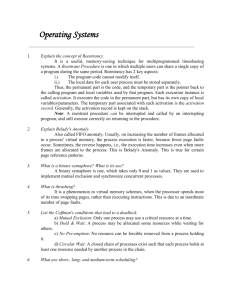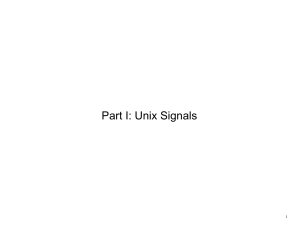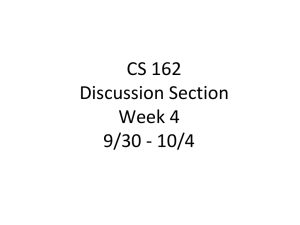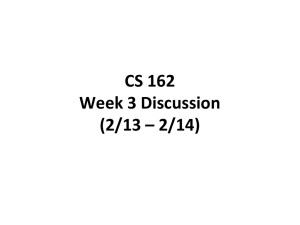Coe628 Midterm Study Guide (2016)
advertisement
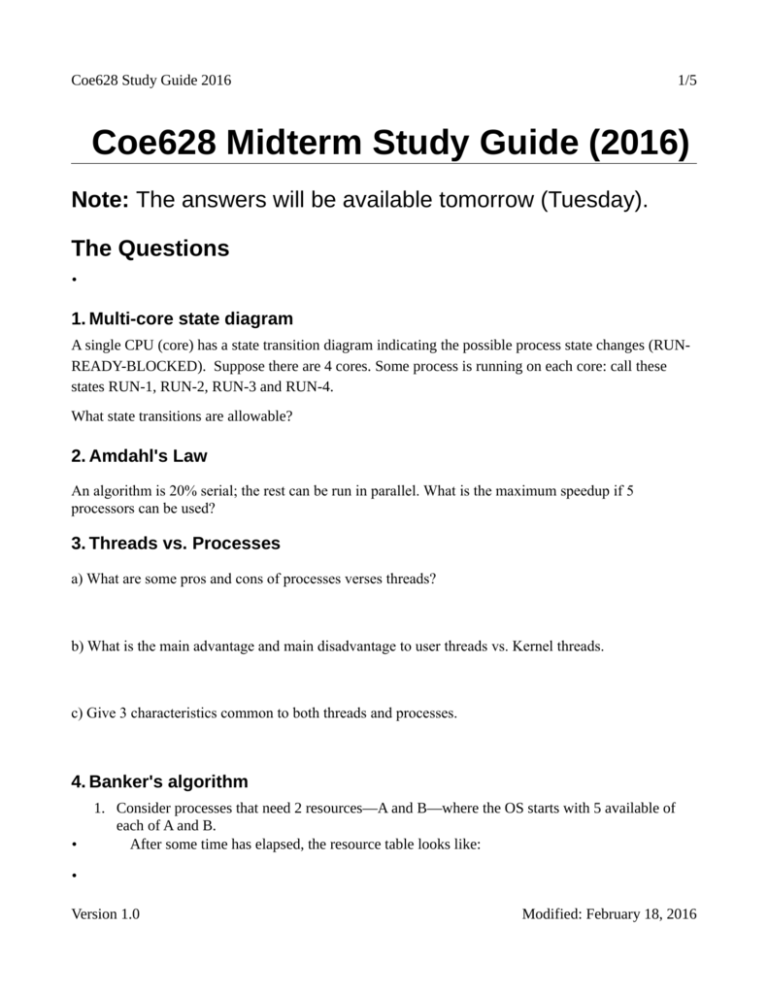
Coe628 Study Guide 2016
1/5
Coe628 Midterm Study Guide (2016)
Note: The answers will be available tomorrow (Tuesday).
The Questions
•
1. Multi-core state diagram
A single CPU (core) has a state transition diagram indicating the possible process state changes (RUNREADY-BLOCKED). Suppose there are 4 cores. Some process is running on each core: call these
states RUN-1, RUN-2, RUN-3 and RUN-4.
What state transitions are allowable?
2. Amdahl's Law
An algorithm is 20% serial; the rest can be run in parallel. What is the maximum speedup if 5
processors can be used?
3. Threads vs. Processes
a) What are some pros and cons of processes verses threads?
b) What is the main advantage and main disadvantage to user threads vs. Kernel threads.
c) Give 3 characteristics common to both threads and processes.
4. Banker's algorithm
•
1. Consider processes that need 2 resources—A and B—where the OS starts with 5 available of
each of A and B.
After some time has elapsed, the resource table looks like:
•
Version 1.0
Modified: February 18, 2016
Coe628 Study Guide 2016
Process
2/5
A
B
Used
Max
Needs
Used
Max
Needs
P0
2
3
1
0
2
2
P1
0
2
2
1
2
1
P2
1
4
3
1
4
3
P3
0
2
2
1
2
1
Totals
2
11
9
3
10
7
OS avail
Suppose
2
2
requests 1 additional A resource.
Can the request be granted?
If yes, should it be granted? i.e. Would the resulting state be safe or unsafe.
If it is safe, show a sequence of Process's that terminate so that every process completes.
If it is unsafe, prove it.
5. Deadlock avoidance
2. ThreadA and ThreadB both need both resources, P and Q, in order to do some work. Each
Thread can acquire a resource with acquireP() or acquireQ(). The resources cannot be shared. If
a Thread tries to acquire a resource that is already in use, it blocks. When a Thread no longer
needs a resource it owns it can release it with releaseP() or releaseQ().
a) Each thread runs its own code and uses the functions acquireP(), acquireQ(), doWork(),
releaseP() and releaseQ(). Each thread releases its resources after invokes “doWork()”; the resources
are released in the opposite order they were obtained.
Show a sequence of operations for each thread so that deadlock is impossible.
ThreadA
Version 1.0
ThreadB
Modified: February 18, 2016
Coe628 Study Guide 2016
3/5
b) Show a sequence of operations for each thread such that deadlock is possible. The show a
specific sequence where deadlock is avoided (thread swithching takes place at just the right times) and
another specific sequence that does result in deadlock.
ThreadA
ThreadB (with sequence that does NOT deadlock)
6. Fork/exec/shell parsing
3. The following program is run. Assume that it's process ID is 1000 and that the next processes
created will have process IDs 1001, 1002, 1003, etc. What is the output from the program?
#include <stdio.h>
#include <stdlib.h>
#include <unistd.h>
int main() {
int i = 3;
int child;
int status;
if((child = fork()) == 0) {
i = i + 2;
printf("X %d %d\n", child, i);
if((child = fork()) == 0) {
printf("Z %d %d\n", child, ++i);
return -2;
}
wait(&status);
printf("A %d %d\n", child, i);
return -1;
}
wait(&status);
printf("Y %d %d\n", child, i);
return 0;
}
Version 1.0
Modified: February 18, 2016
Coe628 Study Guide 2016
4/5
7.
The Answers
1. Multi-core state diagram
The following transitions are legal:
•
RUN-(1 or 2 or 3 or 4) TO BLOCKED
•
RUN-(1 or 2 or 3 or 4) TO READY
•
READY TO RUN-(1 or 2 or 3 or 4)
•
BLOCKED TO READY
2. Amdahl's Law
ANSWER (BASIC): The speed up factor is 2.8.
3. Threads vs. Processes
a) Processes have independent memory spaces; threads share global memory. Thread creation is
simpler than process creation.
b) Kernel threads can be blocked (from a system call) without blocking other threads. If a user-level
thread blocks from a system call, all threads associated with the process will also be blocked.
c) Both threads and processes can be in states such as RUN-READY-BLOCKED. Both Threads and
Processes have associated tables which give the state, saved registers, ids etc. Of each entry.
Version 1.0
Modified: February 18, 2016
Coe628 Study Guide 2016
5/5
4. Banker's algorithm
Yes, it can be granted and yes the result is safe: a possible sequence of terminating processes is P0, P1,
P2, P3.
5. Deadlock avoidance
If each thread acquires the resources in OPPOSITE order, deadlock is POSSIBLE (but NOT
inevitable).
If acquired in the same order, no deadlock can occur.
6. Fork/exec/shell parsing
X
Z
A
Y
0 5
0 6
1002 5
1001 3
Version 1.0
Modified: February 18, 2016








